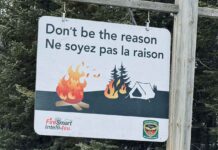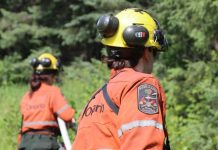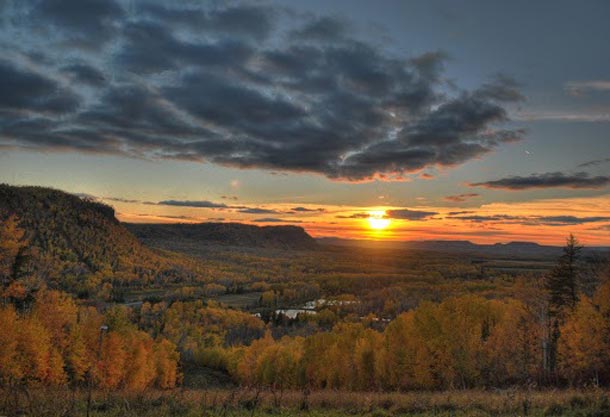
THUNDER BAY – The race is on with just a few days left to comment about the protection of the Loch Lomond Watershed and Nor’ Wester Mountains from a technology that could be old by tomorrow.
Big Thunder Wind Farm – Deadline Looms

The Nor’ Wester Range located in the region of Thunder Bay, ON, Fort William First Nation and Neebing Township has a wind farm slated for the City of Thunder Bay owned property. The Nor’ Wester Mountain range is owned by Fort William First Nation, City of Thunder Bay, Neebing Township and the Provincial and Federal Governments.
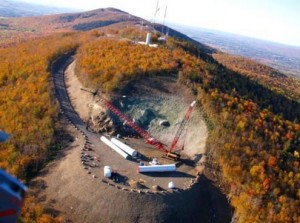
The area of the wind farm is being sited to be built on city owned property, partially on traditional land, in a watershed area and next to a provincially protected Area of Natural Scientific Interest. A large portion of the Nor’ Wester Mountain is slated to be blasted and clear cut to install wind turbines for the industrial wind farm.
[sws_pullquote_right] People have three more days (midnight of June 22 but to be safe people are submitting letters by June 21) to write letters to the Ontario Government (Send submissions to: Submit online comments to www.ebr.gov.on.ca/ (project number 011-8937) Environmental Registry www.ebr.gov.on.ca) to save the beautiful and sacred Nor’ Wester mountains near Thunder Bay, ON. The mountains are one of the world’s oldest cultural history sites and houses one of the most unique biodiversity’s in the world. [/sws_pullquote_right]
No one is disputing the fact the consumer world needs to look at greener initiatives to reduce climate change and environmental damage. Conservations start on an individual level, then moves to a neighborhood, community, city, region, provincial, federal and global level.
Maple Leaf – Canadian Icon
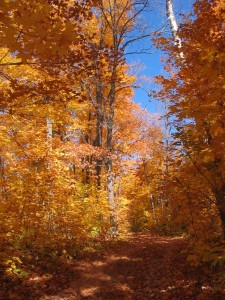
Consumption and climate change reduction means better land management for sustainable futures and appropriately sited industries and to stop urban sprawl, build smaller and more energy efficient homes, drive and walk or bike less, eat healthy and reduce excessive food buying, eating and wasting, shop locally, consume less and spend less on stuff that will end up in the dump anyway, recycle, exercise and keep healthy to reduce medical problems and more industries needed to manage unhealthy people, plant more trees, buy items that are made out of organic materials, promote a vehicle and gas emission reductions in a community and stop polluting and destroying pristine sites for human consumption. The answer is never to build more energy to consume more; the answer is always to build less energy to consume less. Here in Thunder Bay according to OPG and Thunder Bay Hydro we already have green hydro initiatives in place.
While Toronto is “GETTING WITH THE TIMES” and protecting their Niagara Escarpment from any industry because it’s being deemed a world heritage biosphere because people valued their natural assets; the City of Thunder Bay’s Escarpment and Watershed (equally unique to the Niagara Escarpment) could be destroyed. Many local people are not rushing to protect the Nor’ Wester Mountains as a biosphere heritage site possibly because of misinformation and a lack of understanding and appreciation of how rich this land is with a unique biosphere. It’s Thunder Bay’s best and closet natural and cultural asset.
To destroy natural sites vital to all inhabitants of earth is not a step in the right direction towards a greener tomorrow. The wind farm will power 9, 000 homes and electronics a day. The Loch Lomond Watershed can support 9, 000 people a day plus hundreds of different species.
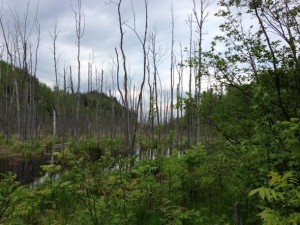
A greener tomorrow does not include destroying pristine natural sites like the Loch Lomond Watershed with pure drinking water for 9, 000 (+) people a day for future generations and an area that houses endangered species, sacred sites and a unique ecosystem.
Water is essential for most plant and animal life. As humans water brings us into the world and it’s what keeps us living in this world. Water is life and it has spirit and without spirit we have no life. The relationship between healthy and nutritional water and healthy people is direct and foundational. In many cultures womyn are known as water carriers and protectors. Many people feel it is our continued duty to protect water from a grassroots level but also according to most government officials.
Water allows us to birth and sustain life. And in the springtime water is flowing prominently from sources like trees and frozen water bodies and it is associated with birth and renewal. This birth and renewal provides earth inhabitants with a place to collect medicine, food and drink from and provides inhabitants with an awaking, cleansing, strength and renewal. Water heals us physically and emotionally and provides us with a place to practice ceremonies, to be spiritual, to collect our thoughts, to teach us and to recreate at. Water is a gift in constant flow and change and this can often reflect our moods. Inhabitants have always lived near water sources to sustain a rich and healthy life.
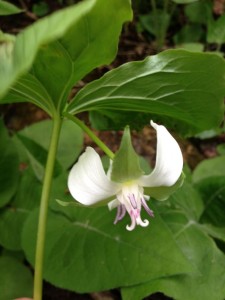
Most large bodies of waters are surrounded by sustainable ecosystems. When a large water source is situated in a special environment where high cliffs, caves, valleys, cliffs, forest and wetlands occur then a variety of micro-climates will add to the diversity and it becomes a rich ecosystem for a vast variety and amount of different species to thrive in.
The Nor’ Wester Mountains houses important ecological and cultural values like the Loch Lomond Watershed, it is a major migratory flyway for hundreds of bird species many of which are species at risk like the warbler, Amerrican Bald Eagle, American white pelican, golden eagle and unique nesting sites for peregrine falcons.
It houses large animals like bears, deer, moose, coyotes and species at risk like the Eastern Cougar, unique and rare vascular plants grow here like the Nodding Trillium and species at risk like the Rocky Mountain Woodsia, Braun’s hollyfern, northern oak fern and rare trees like sugar maples, white pine and yellow birch, special and important beaver dams and water bodies exists in the area is a short list of the hundreds of different of species housed on the Nor’ Wester Moutains.
The Nor’ Wester Moutains has significant cultural values and has been a historical sacred place for First Nations to gather medicines, food and water from and a place to hold ceremonies and to traditionally hunt. The Loch Lomond Watershed is the last bit of land left for Fort William First Nations to traditionally hunt on. If FWFN peoples can no longer hunt because their hunting area is affected then part of their traditions on their very lands could become a cultural genocide.
Water and land resource managers should be looking for ways to collaborate with First Nations people to ensure their values and interests are included in water and land planning. Many unique land and water areas are being polluted by over population, sewage, chemicals, air and gas emissions, motorized vessels, landfills, over consumption, industrial waste and use and farming pollution and our waters. The Loch Lomond Watershed remains healthy water and the area be protected for future generations.
Destroying Valuable Natural Assets?
Destroying such valuable natural assets for the world, Canada and locals to enjoy forever; all for human consumption, for an industry that could be old technology by tomorrow, for a wind farm that is inappropriately sited for energy probably not needed in Thunder Bay because of green hydro initiatives already in place is not a greener tomorrow according to many people.
Progression is leaving our earth in a natural state to be able to live off of water and food that is local and natural. Destroying a pure watershed to fuel homes and electronics rather than fuel First Nations and the Neebing township and beyond with life sustenance called water and natural and traditional foods is not “GETTING WITH THE TIMES”. In fact, Bolivia gave Mother Earth rights this year to protect unique sites like the Nor’ Wester Mountains from industrial development. Protecting unique and natural sites is “GETTING WITH THE TIMES”.
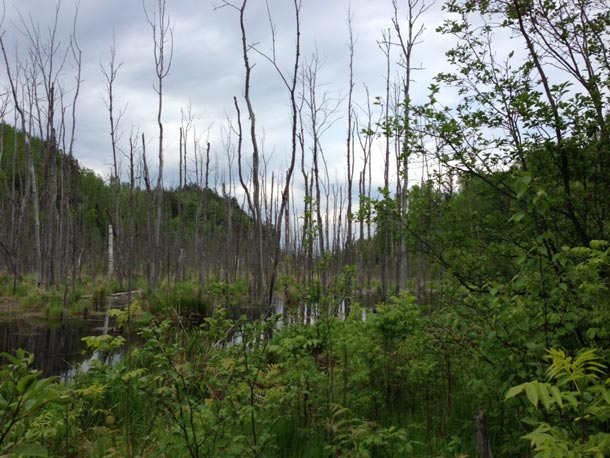
Fort William First Nation and Neebing Township are water customers of Thunder Bay and we all use Lake Superior but if climate change continues according to scientists and it changes the lake levels, algae and inhabitants in years to come and Lake Superior is no longer a good source to drink from; then Fort William First Nation, Neebing and parts of Thunder Bay will need to once again draw from the Loch Lomond Watershed. Fort William First Nation and Neebing are their own municipalities who have the right to decide where they choose to draw their water source from.
Through modernization and environmental damage our relationships with water is degrading. With boil water scarcity, advisories and rationing on the rise in many communities, unhealthy water for all inhabitants globally, with very little real and nutritional water left in the world and with population, industrialization and climate change on the rise, in the future (2030 and beyond) the water will need to be protected at all costs.
People have an opportunity
People have an opportunity to ensure future generations have access to clean water and enough water from a good source and to continue to make it healthy and ultimately make ourselves and all inhabitants healthy. Allowing environmental damage to a pristine watershed like Loch Lomond could be reckless. People have a duty to make a conscious effort to take care of water that provides sustainable life to all inhabitants.
Many have lived near the Nor’ Wester Mountains and Loch Lomond Watershed and have never fully appreciated what grows, lives and thrives there. Many people have appreciated and protected the area in the past and they want to continue protecting it. Humans need to be reflecting on our relationship to water and the challenges around water in our communities. If people are disrespectful and careless with our natural assets and water, then people are putting us and future generations at risk of environmental damages and unsustainable lands. Water is the blood veins of earth and re-routing waters, cutting it off or damaging it could cause unhealthy problems just like if people damaged their own blood veins.
A greener future for many people means applied stewardship by protecting pristine, unique and sacred sites not destroying it to support present and future generations. Green energy starts at home with our own consumption reductions before having to produce more energy. To protect the Nor’ Wester Mountains and Loch Lomond Watershed by June 21, 2013 submit your comments to the Ministry of Ontario.
Get Involved:
Send submissions to: Submit online comments tohttp://www.ebr.gov.on.ca/ (project number 011-8937)
Environmental Registry
www.ebr.gov.on.ca













